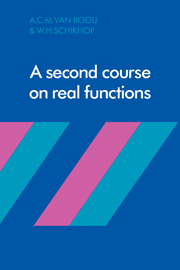1 - Monotone functions
Published online by Cambridge University Press: 06 January 2010
Summary
Continuity of monotone functions
DEFINITION 1.1. Let X ⊂ ℝ. A function ƒ: X → ℝ is called
increasing if x ≤ y implies ƒ(x) ≤ (y),
strictly increasing if x < y implies ƒ(x) < ƒ(y),
decreasing if x ≤ y implies ƒ(x)≥ ƒ(y),
strictly decreasing if x < y implies ƒ(x) > ƒ(y),
for all x, y ∈ X.
ƒ is called monotone if ƒ is increasing or decreasing. If ƒ is either strictly increasing or strictly decreasing, then we call ƒ strictly monotone.
In the following exercises we discuss equivalent definitions of monotony.
* Exercise 1.A. ƒ : ℝ → ℝ is called increasing at p ∈ ℝ if there exists an ε > 0 such that ƒ(x) ≤ ƒ(p)≤ƒ(y) for all x ∈ (p – ε, p) and y ∈ (p,p + ε). Show that ƒ: ℝ → ℝ is increasing if and only if ƒ is increasing at every p ∈ ℝ.
Exercise 1.B. Let c, p, q ∈ ℝ. We say that c is between p and q if either p ≤c ≤ q or q ≤ c ≤ p. Consider the following conditions (a), (b) and (c) for a function ƒ: [0,1] → ℝ.
Information
- Type
- Chapter
- Information
- A Second Course on Real Functions , pp. 9 - 34Publisher: Cambridge University PressPrint publication year: 1982
